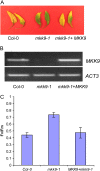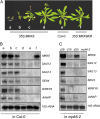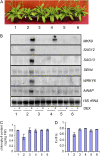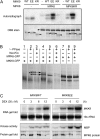An arabidopsis mitogen-activated protein kinase cascade, MKK9-MPK6, plays a role in leaf senescence
- PMID: 19251906
- PMCID: PMC2675715
- DOI: 10.1104/pp.108.133439
An arabidopsis mitogen-activated protein kinase cascade, MKK9-MPK6, plays a role in leaf senescence
Abstract
Leaf senescence is a developmentally programmed cell death process that constitutes the final step of leaf development, and it can be regulated by multiple environmental cues and endogenous signals. The mitogen-activated protein kinase (MAPK) cascades play diverse roles in intracellular and extracellular signaling in plants. Roles of the MAPK signaling module in leaf senescence are unknown. Here, a MAPK cascade involving MKK9-MPK6 is shown to play an important role in regulating leaf senescence in Arabidopsis (Arabidopsis thaliana). Both MKK9 and MPK6 possess kinase activities, with MPK6 an immediate target of MKK9, as revealed by in vitro, in vivo, and in planta assays. The constitutive and inducible overexpression of MKK9 causes premature senescence in leaves and in whole Arabidopsis plants. The premature senescence phenotype is suppressed when MKK9 is overexpressed in the mpk6 null background. When either MKK9 or MPK6 is knocked out, leaf senescence is delayed.
Figures







References
-
- Alzwiya IA, Morris PC (2007) A mutation in the Arabidopsis MAP kinase kinase 9 gene results in enhanced seedling stress tolerance. Plant Sci 173 302–308
-
- Aoyama T, Chua NH (1997) A glucocorticoid-mediated transcriptional induction system in transgenic plants. Plant J 11 605–612 - PubMed
-
- Asai T, Tena G, Plotnikova J, Willmann MR, Chiu WL, Gomez-Gomez L, Boller T, Ausubel FM, Sheen J (2002) MAP kinase signalling cascade in Arabidopsis innate immunity. Nature 415 977–983 - PubMed
-
- Bechtold N, Ellis J, Pelletier G (1993) In planta Agrobacterium-mediated gene transfer by infiltration of Arabidopsis thaliana plants. C R Acad Sci Paris 316 1194–1199
-
- Beers EP, McDowell JM (2001) Regulation and execution of programmed cell death in response to pathogens, stress and developmental cues. Curr Opin Plant Biol 4 561–567 - PubMed
Publication types
MeSH terms
Substances
LinkOut - more resources
Full Text Sources
Molecular Biology Databases

